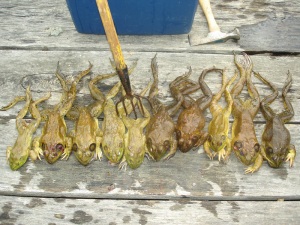Do you like frogs’ legs? Have you ever thought of doing it yourself? If so, then you’ll most likely have been out frog gigging. You gig a frog by stabbing it with a stick that ends in a set of prongs – something like a long fork. In reality, you don’t need a professional gigging stick as any object that can pierce and hold a frog will do.

Gig that frog
So where did the word gig acquire its meaning in relation to gigging a frog?
The word is thought to have originated from the Spanish word, fisga, meaning a type of harpoon. It became corrupted (or Anglicized) as fizgig or fisgig, and its earliest mention is by the writer, Richard Hakluyt. Hakluyt published his Divers Voyages Touching the Discoveries of America in 1582. The Voyages (as it is typically referred to) is a collection of stories from adventurers and explorers, one of whom was John Sparke, a shipmate of Sir John Hawkins. In his tale, he remarks that “Those bonitos…being galled by a fisgig did follow our shippe… 500 leagues.”

Richard Hakluyt - Bristol Cathedral, UK
The word was also used as fishgig, another phonetically motivated deviation from the original fisga. In 1642, Sir William Monson, in his Naval Tracts, wrote that “These Fishes are taken with… Fishgigs.” It then appears as a shortened form in such works as the Journals of Lewis and Clark (1804-1806); when referring to porpoises, they wrote that “…the indians sometimes gig them (356).” [1]
Here the word has taken on the role of a verb; to gig. It was only a matter of time before gigging was used to describe the act of frog gigging.
The word gig has a number of other meanings – but that’s a new story.
Notes: [1] Bergon, F. (1997). The Journals of Lewis and Clark. Penguin Book.
